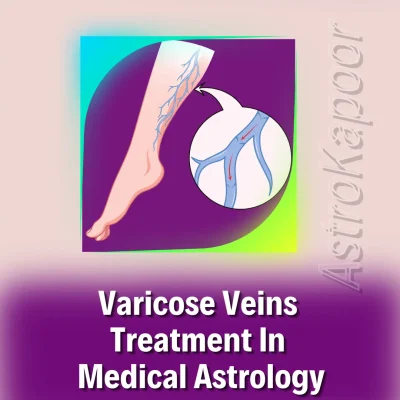Book NowWaiting Time - 22-25 Working Days
(Earlier Appointment depends on the availability of Slots)
Consultation will be given through audio call.
Varicose Veins Treatment in Medical Astrology
What are Varicose Veins?
Varicose veins are a common condition that occurs when the veins, usually in the legs, become enlarged, twisted, and swollen. They can appear as dark blue or purple bulges on the skin's surface. While often considered a cosmetic concern, varicose veins can sometimes cause discomfort and lead to more serious health issues if left untreated.
Causes of Varicose Veins
The primary cause of varicose veins is a condition called
venous insufficiency. This occurs when the valves in the veins that help blood flow back to the heart become weakened or damaged. As a result, blood pools in the veins, causing them to swell and become visible on the skin's surface.Several factors can contribute to the development of varicose veins:
- Heredity: A family history of varicose veins increases the likelihood of developing them.
- Age: As you get older, the veins can lose their elasticity, increasing the risk of varicose veins.
- Gender: Women are more likely to develop varicose veins, partially due to hormonal changes during pregnancy, menstruation, and menopause.
- Prolonged Standing or Sitting: Jobs that require prolonged periods of standing or sitting can increase the risk of developing varicose veins.
- Obesity: Excess weight can put additional pressure on the veins and contribute to the development of varicose veins.
- Pregnancy: Pregnancy increases the pressure on the veins in the pelvis and legs, which can lead to varicose veins.
- Lack of Physical Activity: Regular exercise helps improve blood circulation and reduces the risk of developing varicose veins.
- History of Blood Clots: A history of blood clots can damage the valves in the veins, increasing the likelihood of varicose veins.
Symptoms of Varicose Veins
Varicose veins are enlarged, twisted veins that often appear on the legs and feet. They are usually blue or dark purple in color and can be painful or cause discomfort.
Common Symptoms:
- Visible Bulging Veins: The most noticeable symptom is the appearance of twisted, bulging veins just beneath the skin's surface.
- Pain and Discomfort: Aching, throbbing, or a feeling of heaviness in the legs, especially after prolonged periods of standing or sitting.
- Swelling: Swelling in the legs, ankles, and feet, especially at the end of the day.
- Muscle Cramps: Frequent muscle cramps, particularly at night.
- Itching and Burning: The skin around the affected veins may itch or burn due to poor blood circulation.
- Skin Changes: Over time, the skin around varicose veins may become discolored or darkened, indicating blood pooling in the veins.
- Skin Ulcers: In severe cases, varicose veins can lead to skin ulcers, especially near the ankles, which can be painful and slow to heal.
- Restless Legs: Some individuals experience restless legs syndrome, characterized by an uncontrollable urge to move the legs, often accompanied by discomfort.
Treatment Options for Varicose Veins
In most cases, varicose veins are not a serious medical condition and can be managed with lifestyle changes and conservative measures. These may include:
Home Remedies and Lifestyle Changes:
- Regular Exercise: Activities like walking and swimming promote blood circulation and help prevent varicose veins.
- Elevating the Legs: Keeping the legs above heart level reduces swelling and improves blood flow.
- Wearing Compression Stockings: These apply pressure to the legs, enhancing blood circulation and reducing discomfort.
- Avoiding Prolonged Standing or Sitting: Regularly changing positions and avoiding long periods of inactivity can help prevent varicose veins.
- Healthy Diet: Maintaining a healthy weight and consuming a diet rich in fiber supports better circulation.
Medical Treatments:
If conservative measures do not provide sufficient relief, or if the varicose veins cause significant discomfort or complications, medical treatments may be recommended:
- Sclerotherapy: A procedure where a solution is injected into the affected veins, causing them to collapse and fade from view.
- Laser Therapy: Laser energy is used to close off and shrink varicose veins.
- Endovenous Ablation: A minimally invasive procedure that uses heat to seal the affected veins.
- Surgical Stripping: Removing the affected veins through small incisions.
When to See a Doctor
It is important to consult a healthcare professional if you experience:
- Severe pain or discomfort in the legs.
- Swelling that worsens over time.
- Skin ulcers or open sores near the affected veins.
- Bleeding from varicose veins.
- Increased warmth or redness around the veins, which could indicate an infection.
Taking timely action can help prevent complications and improve overall vein health.
For a personalized consultation on
Varicose Veins Treatment in Medical Astrology, book your appointment today!
